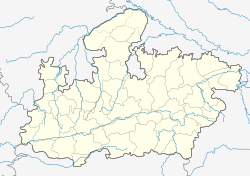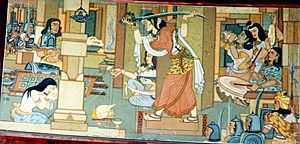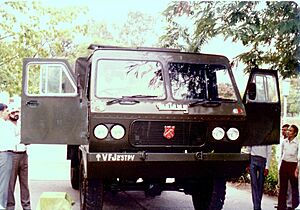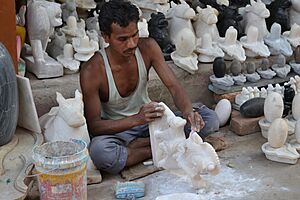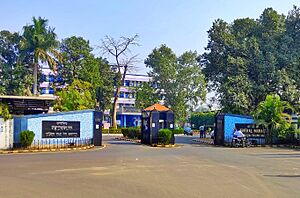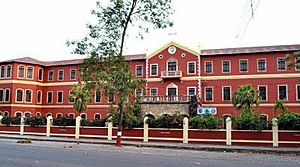Jabalpur facts for kids
Quick facts for kids
Jabalpur
Jubbulpore
|
|
|---|---|
|
From top: Bhedaghat, Dhuandhar Falls, St. Aloysius Senior Secondary School, Madhya Pradesh High Court, Jabalpur Engineering College, Madan Mahal Fort,
|
|
| Country | |
| State | |
| District | Jabalpur |
| Government | |
| • Type | Mayor–Council |
| • Body | Jabalpur Municipal Corporation |
| Area | |
| • Metropolis | 263.49 km2 (101.73 sq mi) |
| Elevation | 412 m (1,352 ft) |
| Population
(2011)
|
|
| • Metropolis | 1,055,525 |
| • Rank | 40th |
| • Density | 4,005.94/km2 (10,375.34/sq mi) |
| • Metro | 1,267,564 |
| • Metro rank | 38th |
| Demonyms | Jabalpurians, Jabalpuriya, Jabalpurites |
| Time zone | UTC+5:30 (IST) |
| PIN |
482001 to 482011
|
| Telephone code | 0761 |
| ISO 3166 code | IN-MP |
| Vehicle registration | MP-20 |
| Sex ratio | 929 ♀ / 1000 ♂ |
| Average Literacy Rate | 82.13% |
| Official language | Hindi |
Jabalpur, once called Jubbulpore, is a city in India. It is located by the Narmada River in the state of Madhya Pradesh. It is one of the biggest cities in its state and among the largest in India. Jabalpur is an important city for government work in its area. It's also where the main court for Madhya Pradesh is located. Many believe the game of snooker started here. Jabalpur is a major hub for railways in central India. It also has one of India's largest army bases. The city is famous for its beautiful Marble Rocks along the Narmada River at Bhedaghat. Jabalpur is also known as 'Sanskardhani', which means 'The Cultural Capital'. This name highlights the city's rich history and culture. Jabalpur was one of the first cities chosen for the Smart Cities Mission in India.
Contents
The Name of Jabalpur
People have different ideas about how Jabalpur got its name. One popular idea is that it was named after a wise man called Jabali. He used to meditate by the Narmada River.
Another idea is that the name comes from the Arabic language. In Arabic, jabal means granite or huge rocks. There were many such rocks in the Jabalpur area. During British rule, the city's name was spelled 'Jubbulpore'. In 2006, the Jabalpur city council officially changed the name back to Jabalpur.
A Look at Jabalpur's Past
Ancient Times and Kingdoms
Old stories say that three evil spirits, called Asuras, lived in the Jabalpur area. The Hindu god Shiva defeated them. The main Asura, Tripurasura, gave the city its old name, Tripur Tirth. This area was part of the ancient Chedi Kingdom, known from the Mahabharata stories.
Evidence from around 300 BCE shows that the Maurya Empire was present here. After this empire fell, Jabalpur became a small independent city. Later, it was ruled by the Satavahana dynasty. After them, local rulers called the Bodhis and Senas took over. Eventually, Jabalpur became a smaller state under the powerful Gupta Empire.
Kalachuri and Gond Rulers
The Kalachuri Dynasty took control of the region in 875 CE. A famous Kalachuri ruler was Yuvaraja-Deva I. One of his ministers helped build the Chausath Yogini Temple near Bhedaghat.
Jabalpur was a very important place during the time of the Gond kings of Garha-Mandla. A Gond ruler named Madan Shah built a watchtower and a small fort at Madan Mahal in Jabalpur.
In the 1500s, the Gond king Sangram Shah ruled from Singorgarh fort. Rani Durgawati was a brave princess who married a Gond king. She cared a lot about saving water. She built over 85 ponds in Jabalpur, like those in Ranital and Hanumantal.
Later, the Gond king Hriday Shah moved his court to the Mandla fort. He also worked to secure water sources. In 1742, the Marathas invaded the kingdom. They made it a state that had to pay taxes to the Maratha Empire.
Maratha and British Rule
The Maratha rulers finally took over the weakened Gond kingdom in 1781. Around 1798, the Marathas gave the Narmada valley to the Bhonsle kings of Nagpur. They ruled until 1818, when the British East India Company took control after a battle.
The British made Jabalpur a main center for their administration. They also set up a large army base here. Under British rule, Jabalpur became the capital of the Saugor and Nerbudda Territories. This area later became part of the Central Provinces.
A key event was the Tripuri Congress session in 1939. Subhash Chandra Bose led this meeting. Mahatma Gandhi visited Jabalpur four times. The city has a special gate, Kamania Gate, built to remember these important events. After India became independent in 1947, the Central Provinces became the state of Madhya Pradesh. The city's old buildings still show the style of British colonial architecture.
Jabalpur's Climate and Nature
Weather Patterns
| Weather chart for Jabalpur | |||||||||||||||||||||||||||||||||||||||||||||||
|---|---|---|---|---|---|---|---|---|---|---|---|---|---|---|---|---|---|---|---|---|---|---|---|---|---|---|---|---|---|---|---|---|---|---|---|---|---|---|---|---|---|---|---|---|---|---|---|
| J | F | M | A | M | J | J | A | S | O | N | D | ||||||||||||||||||||||||||||||||||||
|
19
24
8
|
16
28
11
|
16
34
16
|
5
39
21
|
11
42
26
|
169
38
26
|
382
31
24
|
458
29
23
|
188
31
23
|
39
32
19
|
12
29
12
|
11
25
9
|
||||||||||||||||||||||||||||||||||||
| temperatures in °C precipitation totals in mm source: IMD |
|||||||||||||||||||||||||||||||||||||||||||||||
|
Imperial conversion
|
|||||||||||||||||||||||||||||||||||||||||||||||
Jabalpur has a humid subtropical climate. This type of weather is common in north-central India. Summer starts in late March and lasts until June. May is the hottest month, with temperatures often above 40°C.
After summer comes the southwest monsoon season. This lasts until early October. Most of the rain falls from July to September. The city gets about 1386 mm of rain each year. Winter begins in late November and ends in early March. January is the coldest month, with an average temperature around 15°C.
Jabalpur was ranked the 2nd best "National Clean Air City" in India in 2024.
Ancient Animals
Long ago, a type of dinosaur called Laevisuchus indicus lived near Jabalpur. Its bones were found here in 1917. Another small dinosaur, Jubbulpuria tenuis, was also found. Scientists later realized it was the same as Laevisuchus indicus.
People of Jabalpur
| Religions in Jabalpur city | ||||
|---|---|---|---|---|
| Religion | Percent | |||
| Hindu | 79.39% | |||
| Muslim | 15.03% | |||
| Jain | 2.26% | |||
| Christian | 1.59% | |||
| Sikh | 1.05% | |||
| No religion stated | 0.31% | |||
| Buddhist | 0.34% | |||
| Others† | 0.03% | |||
| Distribution of religions | ||||
| Year | Population |
|---|---|
| 2011 |
1,268,848
|
| 2012 |
1,295,000
|
| 2013 |
1,320,000
|
| 2014 |
1,360,000
|
| 2015 |
1,385,000
|
| 2016 |
1,400,000
|
| 1,440,000 |
1,440,000
|
| 2018 |
1,450,000
|
In the 2011 India census, the city of Jabalpur had a population of over 1 million people. The larger Jabalpur metropolitan area had a population of about 1.2 million.
Jabalpur's Economy
The Narmada River helps make Jabalpur a farming area. The fertile soil in the Narmada basin grows crops like wheat, rice, and millet. Important commercial crops include pulses, oilseeds, and cotton.
Jabalpur has many different industries. Many are based on minerals found in the area. The ready-made clothing industry is also a big part of the city's production.
Defence factories started here in the early 1900s. Jabalpur has several factories that make products for the Indian Armed Forces. These include the Vehicle Factory Jabalpur, Grey Iron Foundry, Gun Carriage Factory Jabalpur, and Ordnance Factory Khamaria. The Gun Carriage Factory, started in 1904, makes gun parts and other war products. The Vehicle Factory Jabalpur (VFJ) makes trucks and other vehicles for defence.
The armed forces are a big part of the city's economy. Jabalpur has three army regimental centers. It is also the army headquarters for several states. The presence of these military bases and factories has helped the city's growth.
Key Industries in Jabalpur
Jabalpur has many important industries, including:
- Ready-made clothing
- Poultry farms
- Electrical goods
- Sawmills
- Wood cutting
- Limestone products
- Building materials
- Glassware
- Telephone parts
- Furniture making
- Gelatin factory
- Steel structures
- Cement industries
- Tobacco business
- Retail shops
- Food processing
- Bottling plants for Coca-Cola and Parle
Technology and Business
The Madhya Pradesh State Electronics Development Corporation has built an I.T. park called Techno Park. It is located in Bargi Hills, about 22 km from Jabalpur airport. Paytm, a big online payment company, started its operations in Jabalpur in 2018.
Culture and Food
Local Delicacies
Jabalpur is known for its delicious sweets and snacks. Some local favorites include Doodh ka Halwa, Kalakand, and Khoye ki Jalebi. Khoye ki Jalebi is very popular in Madhya Pradesh. It was invented by Harprasad Badkul in 1889 at his shop. Other tasty treats are Mawa-Bati, Khoprapak, and Imarti.
Fun Places to Visit in Jabalpur
Jabalpur is a great place for tourists in Central India. Here are some famous spots:
- Marble Rocks in Bhedaghat
- Hanumantal Bada Jain Mandir
- Madan Mahal
- Dhuandhar Falls
- Chausath-Yogini Temple
- Gwarighat
- Balancing Rock near Madan Mahal Fort
- The Shiv Statue at Kachnar City
You can also easily visit famous tiger reserves from Jabalpur. These include Kanha National Park, Bandhavgarh National Park, and Pench National Park. The large Nauradehi Wildlife Sanctuary is also nearby. The new Veerangana Durgavati Tiger Reserve is also close to Jabalpur.
Temples and Forts
The Hanumantal Bada Jain Mandir is a Jain temple from the 17th century. It looks like a fortress with many towers. It has 22 shrines, making it the largest independent Jain temple in India.
Madan Mahal is a fort built by the Gond king Madan Shahi in 1116. It sits on top of a hill in Jabalpur.
Kachnar City is famous for its 76-foot-high Shiva statue. Inside the statue, there is a cave with copies of Shiva lingas from 12 shrines across India.
Museums and Nature Parks
The Rani Durgawati Museum was built in 1964 to honor Rani Durgavati. The museum displays old items, sculptures, and things related to Mahatma Gandhi.
Dumna Nature Reserve Park is a great place for nature lovers. It is located near Jabalpur Airport. The Khandari Dam, which provides drinking water to the city, is also here. The Bargi Dam Reservoir is a popular spot for boat rides.
River Adventures
You can enjoy boat rides along the Narmada River, about 15 km from the city. The boat trip takes you through the amazing Marble Rocks. Here, the river has carved a gorge about 8 km long through soft marble. You can also see the Dhuandhar Falls, a very popular waterfall.
Lamheta Ghat and Tilwara Ghat are well-known bathing spots on the Narmada River. The Tilwadeshwar temple is near Tilwara Ghat. It is also the place where Mahatma Gandhi's ashes were scattered.
Other interesting places near the city include Paat Baba Mandir, Gupteshwar Mandir, and Pisanhari Ki Madiya. The latter is a historic Jain pilgrimage site.
Getting Around Jabalpur
By Air
The Jabalpur Airport (JLR), also known as Dumna Airport, is about 20 km from the city center. It is near the Dumna Nature Reserve Park. This is the only airport in eastern Madhya Pradesh. It is also the easiest airport to use for visiting the National Parks and Wildlife Sanctuaries around Jabalpur. The airport has direct flights to major cities like New Delhi, Mumbai, and Hyderabad.
By Train
Jabalpur Junction railway station is one of the main train stations in the city. Madan Mahal railway station is right in the heart of Jabalpur.
Jabalpur is home to the main office of the West Central Railways (WCR). It is also one of the three main railway divisions in WCR. Jabalpur Junction has good train connections to many cities across India.
By Road
Jabalpur has excellent road connections. Several National Highways meet in Jabalpur. These include NH 45 to Bhopal, NH 34 to Nagpur, and NH 30 to Varanasi. The city also has a good network of state highways.
A 114 km Ring Road is being built around Jabalpur. It will be the second-longest ring road in India. Madhya Pradesh's longest elevated road is also in Jabalpur and is almost finished.
Learning in Jabalpur
Jabalpur became a center for higher education in the late 1800s. Institutions like the Hitkarini Sabha were started by local people in 1868. Robertson College (now Government Science College) was moved to Jabalpur in 1873. Government Engineering College, Jabalpur was the first technical school in Central India. IIITDM Jabalpur was founded in 2005.
Many famous scholars and politicians have spent time in Jabalpur. These include Ravishankar Shukla, Rajneesh, and Maharishi Mahesh Yogi.
Jabalpur is known for its many universities. These include Rani Durgavati University, Madhya Pradesh Medical Science University, and Jawaharlal Nehru Agricultural University. There are also important forest research centers here.
The city also has a Government Medical College called Netaji Subhash Chandra Bose Medical College. A large Government Cancer Institute will soon open next to it.
Media and News
Several television news channels have offices in Jabalpur. The city also has various cable TV operators.
Newspapers
Both national and local newspapers are published in Jabalpur in Hindi and English.
| Newspaper | Language | Founded |
|---|---|---|
| Naiduniya | Hindi | 1947 |
| Patrika | 2009 | |
| Nava Bharat | 1934 | |
| Deshbandhu | 1959 | |
| Hari Bhoomi | 1996 | |
| The Times of India | English | 1838 |
| Hindustan Times | 1924 | |
| Hindustan | Hindi | |
| The Hitavada | English | 1911 |
| Business Standard | English, Hindi | 1975 |
| Dainik Bhaskar | Hindi | 1958 |
| Yash Bharat | 2006 |
Radio Stations
Jabalpur has several radio stations:
| Name | Frequency (MHz) | Tagline |
| Red FM | 93.5 | Bajaate raho |
| MY FM | 94.3 | Jiyo Dil Se! |
| Radio Mirchi | 98.3 | It's Hot! |
| Radio Orange | 106.4 | Kuch Khatta Kuch Meetha |
| Akashvani | 102.9 |
Akashvani Jabalpur also broadcasts on AM radio.
Sports in Jabalpur
The city has two main stadiums: Ravishankar Shukla Stadium and Rani Tal Stadium. It is widely believed that the game of snooker was created in Jabalpur in 1875. A British Army officer named Colonel Sir Neville Chamberlain developed a new version of a game called black pool by adding colored balls. This new game was later named snooker.
Famous People from Jabalpur
Many notable people have connections to Jabalpur:
- Rani Durgavati (1524–1564) - A brave queen.
- Jaya Bachchan - A famous actress.
- Arjun Rampal - A well-known actor.
- Ashutosh Rana - An actor.
- Osho Rajneesh - A spiritual guru.
- Maharshi Mahesh Yogi - A spiritual leader.
- Subhadra Kumari Chauhan - A famous poet.
- Harishankar Parsai - A noted writer.
- Arnab Goswami - A journalist.
Images for kids
See also
 In Spanish: Jabalpur para niños
In Spanish: Jabalpur para niños









